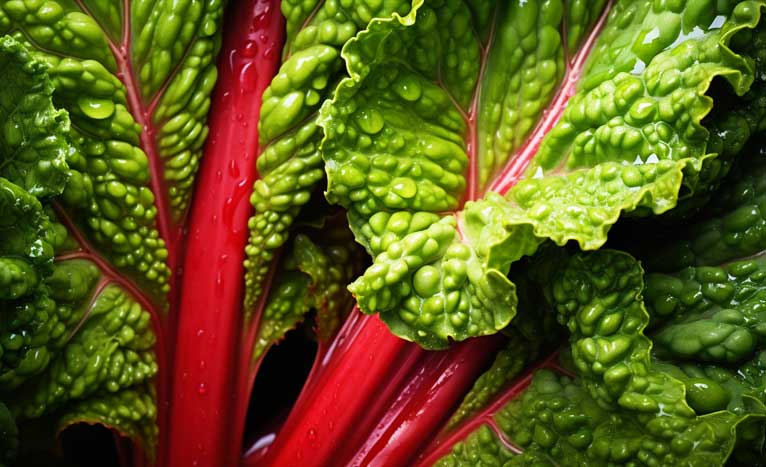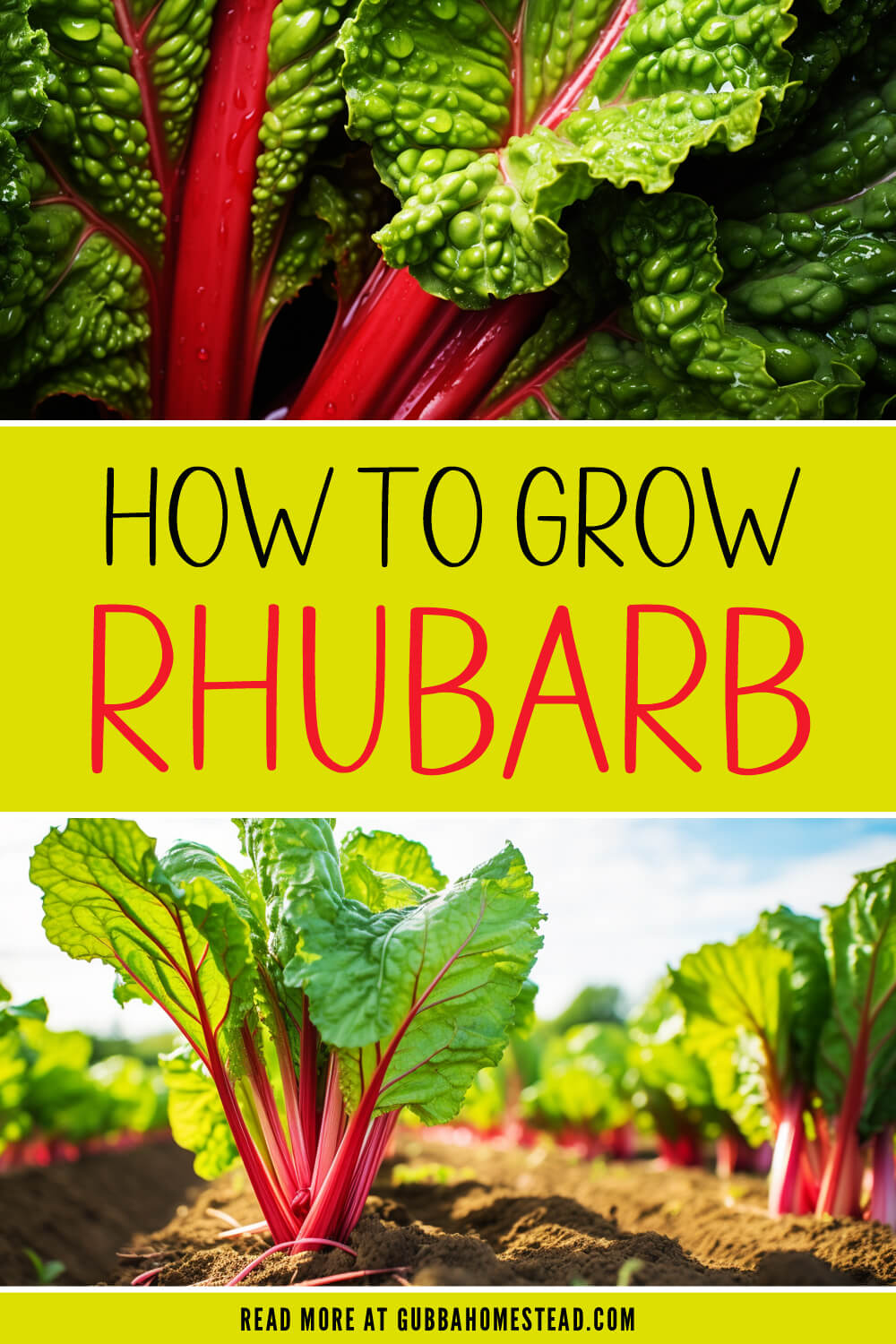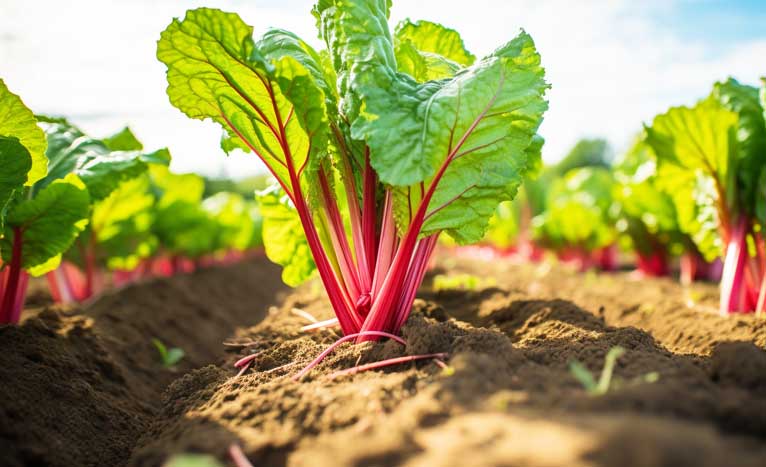Rhubarb is a unique and versatile plant known for its tart and tangy stalks. Whether you enjoy it in pies, jams, or as a flavorful addition to savory dishes, growing your own rhubarb can be a rewarding experience. In this blog, I will provide you with step-by-step instructions on how to grow rhubarb and enjoy a bountiful harvest of this delicious perennial plant.
Seriously, rhubarb is one of my favorite homestead garden staples! I grew up with it and it reminds me of fun family memories, so I absolutely needed it in my garden!
Understanding Rhubarb
Rhubarb is a perennial plant that belongs to the Polygonaceae family. It is primarily grown for its edible stalks, which are rich in vitamins and minerals. Rhubarb plants have large, vibrant green leaves and thick, fleshy stalks that can range in color from green to red, depending on the variety.
Because it is a perennial plant, it will come back every year. What a wonderful treat and gift to have to do the hard work once and then have a plant come back yearly.
Perennials are my favorite!

Selecting Rhubarb Varieties
When choosing rhubarb varieties, consider your climate and personal preferences. Some popular varieties include:
Victoria Rhubarb: A classic variety with green stalks that turn red as they mature.
Crimson Cherry: This variety produces vibrant red stalks with a slightly sweeter flavor.
Canada Red Rhubarb: Known for its deep red stalks and excellent flavor.
Raspberry Red: A newer variety with bright red stalks and a hint of raspberry flavor.
I personally have the Canada Red as they grow well in my climate. I have five small patches of them—maybe a 3 foot by 8 foot space and I have so much rhubarb that I share with friends!
Choosing the Right Location
Rhubarb thrives in cool climates and requires a location that receives full sun or partial shade. Choose a spot in your garden that provides at least 6-8 hours of sunlight per day. Ensure that the area has well-drained soil, as rhubarb does not tolerate waterlogged conditions.
My rhubarb receives shade by a tree near by it and the rhubarb in my garden growing up received shade from shrubs and trees nearby. Shade helps your rhubarb thrive.
Preparing the Soil for Rhubarb Planting
Prepare the soil before planting rhubarb to create optimal growing conditions. Start by removing any weeds or grass from the planting area. Loosen the soil to a depth of about 12 inches, incorporating organic matter such as compost or well-rotted manure. This improves soil fertility and drainage, creating a favorable environment for rhubarb roots.
Planting Rhubarb Crowns
Rhubarb is usually propagated using crowns, which are sections of mature rhubarb plants.
Follow these steps to plant rhubarb crowns:
- Dig a hole that is wide and deep enough to accommodate the crown without bending the roots.
- Place the crown in the hole, positioning it so that the bud is about an inch below the soil surface.
- Backfill the hole with soil, gently firming it around the crown.
- Water thoroughly to settle the soil around the roots.
Watering and Mulching Rhubarb Beds
Proper watering is essential for rhubarb plants. Water regularly, aiming for a consistent moisture level in the soil. Avoid overwatering or letting the soil dry out completely. Applying a layer of organic mulch around the base of the plants helps retain moisture, suppresses weed growth, and regulates soil temperature.
Fertilizing Rhubarb Plants
Rhubarb benefits from regular fertilization to support its growth and development. In early spring, apply a balanced fertilizer or compost around the base of the plants. Avoid applying fertilizer directly on the rhubarb stalks. If the plants show signs of nutrient deficiency, such as pale leaves, consider a foliar spray with a liquid fertilizer.
Rhubarb Care and Maintenance
Maintaining healthy rhubarb plants involves a few essential care practices. Here are some key steps:
Weed regularly to prevent competition for nutrients and water.
Monitor the soil moisture levels and adjust watering accordingly.
Remove any flower stalks that appear, as they can divert energy from stalk production.
Divide mature rhubarb plants every 4-5 years to maintain vigor and productivity.
As soon as you see the flower stalks appear, just chop them off. Similar to garlic scapes, if you don’t cut the flowers then the plant will redirect its energy to producing the flowers instead of the stalks, and we don’t want that!
Harvesting Rhubarb Stalks
You can start harvesting rhubarb stalks once the plants are well-established, usually in their second or third year. Follow these guidelines for proper harvesting:
Only harvest stalks that are thick and fully developed. Avoid removing more than one-third of the stalks at a time.
Hold the stalk near its base and gently pull it away from the plant, twisting slightly to detach it.
Discard the leaves, as they are toxic and should not be consumed.
Rhubarb stalks are best when they are firm and crisp, with a good coloration.
Storing and Using Rhubarb
Freshly harvested rhubarb can be stored in the refrigerator for up to two weeks. To extend its shelf life, blanch the stalks in boiling water for a minute and then freeze them. Rhubarb can be used in a variety of culinary creations, such as pies, crumbles, jams, sauces, and even savory dishes like chutneys or roasted alongside meats.
What I love most about rhubarb is that you can add it to recipes and can it up! I made rhubarb BBQ sauce, which is now one of my favorite BBQ sauces, and it used up a bunch of my frozen rhubarb. If you can’t preserve all of your rhubarb when it comes in, just freeze it for later—easy! I also recommend my Grandma’s Rhubarb crisp and Strawberry Rhubarb Cobbler dessert recipes!
Common Rhubarb Problems and Solutions
While rhubarb is generally a low-maintenance plant, it can face some challenges.
Here are a few common problems and their solutions:
Crown Rot: Ensure proper drainage and avoid overwatering to prevent crown rot.
Aphids: Use insecticidal soap or a strong blast of water to control aphid infestations.
Leaf Spot: Remove and dispose of infected leaves to prevent the spread of leaf spot.
Frequently Asked Questions About Rhubarb
Can I grow rhubarb from seeds?
While rhubarb can be grown from seeds, it is a slow and unpredictable process. It is best to start with rhubarb crowns for easier and faster results.
When is the best time to harvest rhubarb?
Harvest rhubarb stalks in the spring when they are thick and fully developed. Avoid harvesting in the first year to allow the plants to establish themselves.
Can I divide rhubarb plants?
Yes, dividing mature rhubarb plants every 4-5 years helps maintain their vigor and productivity. Dig up the plant and separate the crowns, ensuring each division has viable buds and roots.
Are rhubarb leaves poisonous?
Yes, rhubarb leaves contain oxalic acid and other compounds that are toxic when consumed. Only consume the edible stalks and discard the leaves properly.
How long does it take for rhubarb to reach maturity?
Rhubarb plants typically take 2-3 years to reach full maturity and produce a bountiful harvest


